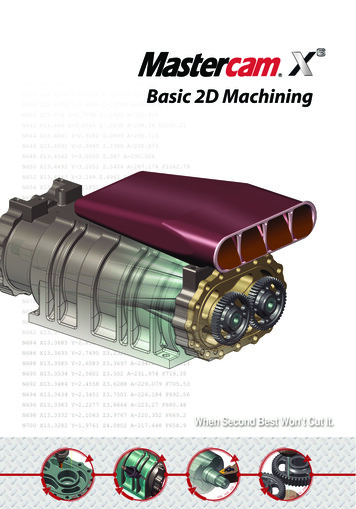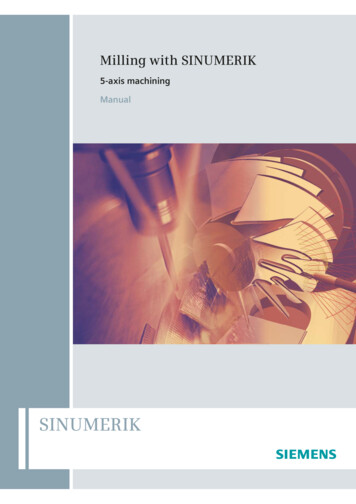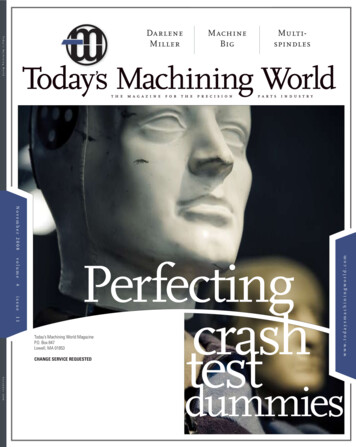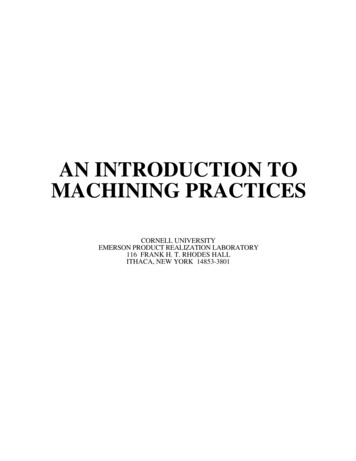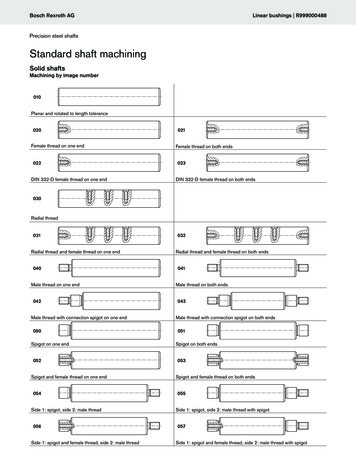
Transcription
2 - Machining Fundamentals –MeasurementManufacturing Processes - 2, IE-352Ahmed M El-Sherbeeny, PhDSpring-2014
Learning Objectives Measure to 1/64” (.5 mm) with a steel rule Reading an Inch-based Vernier Scale Reading a Metric-based Vernier Scale Measure to 0.001”(.02 mm) using Vernier measuring tools Measure to .0001” (.002 mm) using a Vernier micrometer caliper Use a dial indicator Employ the various helper measuring tools found in a machineshop Identify and use various types of gages found in a machine shop
CONTENTS Steel Rule Micrometer Caliper (inch, metric) Vernier Micrometer Vernier Caliper (inch, metric) Dial Caliper Universal Bevel Protractor Gages
Units of MeasurementThe science that deals with systems of measurement is called metro logy.In addition to using US Conventional units of measure (inch, foot, etc.),industry is gradually converting to metric units of measure (millimeter,meter, etc.), called the International System of Units (abbreviated SI).A micrometer is one-millionth of a meter (0.000001 m).This rule can be used to make measurements in bothUS Conventional and SI Metric units.
Reading a RuleYou must first learn to read a rule to 1/64” and 0.5 mm.Then, you can progress through 1/1000” (0.001”) and 1/100 mm (0.01mm) by learning to use micrometer and Vernier-type measuringtools.Finally, you can progress to 1/10,000” (0.0001”) and 1/500 mm (0.002mm) by using the Vernier scale on some micrometers.
Different Types of Rules6” steel ruleRule withadjustablehookNarrow ruleSmall ruleswith holder
Reading the Rule (US Conventional)This figure shows the differentfractional divisions of the inch from 1/8to 1/64 The lines representing the divisionsare called graduations.On many rules, every fourth graduationis numbered on the 1/32 edge, and everyeighth graduation on the 1/64 edge.To become familiar with the rule, beginby measuring objects on the 1/8 and 1/16scales. Once you become comfortablewith these scales, begin using the 1/32and 1/64 scales.Some rules are graduated in lOths, 2Oths, 5Oths, and lOOths!!Fractional measurements are always reduced to the lowest terms. Ameasurement of 14/16” is reduced to 7/8”, 2/8” becomes 1/4”, and so on.
Reading the Rule (Metric)Most metric rules aredivided into millimeter orone-half millimetergraduations.They are numbered every 10mm (1 cm).The measurement isdetermined by counting thenumber of millimeters.1.0 mm
The Micrometer CaliperA Frenchman, Jean Palmer, devised and patented a measuring tool thatmade use of a screw thread, making it possible to read measurementsquickly and accurately without calculations.It consisted of a series of engraved lines on the sleeve and around thethimble.thimbleThe micrometer caliper, also known as a“mike,” is a precision tool capable ofmeasuring to 0.001” or 0.01 mm.When fitted with a Vernier scale, it willread to 0.0001” or 0.002 mm.The device, called Systeme Palmer, is the basis for the modernmicrometer caliper.
Types of MicrometersAn outside micrometer measuresexternal diameters and thickness,An inside micrometer has many uses,including measuring internaldiameters of cylinders, rings, andslots. The range of a conventionalinside micrometer can beextended by fitting longerrods to the micrometer head. The range of a jaw-typeinside micrometer is limited to1” or 25 mm. The jaw-typeinside micrometer has a scalegraduated from right to left.The divisions on the sleeve are numbered in thereverse order of a conventional outside micrometer.outsideinside
Types of MicrometersA micrometer depth gage measures the depths of holes, slots, andprojections. The measuring range can be increased by changing to longerspindles. Measurements are read from right to left.
Types of MicrometersA screw-thread micrometerhas a pointed spindle and adouble-V anvil shaped tocontact the screw thread.It measures the pitch diameter of the thread, which equals the outside(major) diameter of the thread minus the depth of one thread.Since each thread micrometer is designed to measure only a limited numberof threads per inch, a set of thread micrometers is necessary to measure afull range of thread pitches.
Reading an Inch-Based MicrometerA micrometer uses a very precisely made screw thread that rotates in afixed nut.The screw thread is ground on the spindle and is attached to the thimble.The spindle advances or recedes from the anvil as the thimble is rotated.The threaded section has 40 threads per inch; therefore, each revolution ofthe thimble moves the spindle 1/40” (0.025”).
Reading an Inch-Based MicrometerEvery fourth division is numbered, representing 0.1”, 0.2”, etc.The line engraved lengthwise on the sleeve is divided into 40 equal partsper inch (corresponding to the number of threads per inch on thespindle). Each vertical line equals 1/40”, or 0.025”.The beveled edge of the thimble is divided into 25 equal parts around itscircumference. Each division equals 1/1000” (0.001”).On some micrometers, every division is numbered, while every fifth division isnumbered on others.The micrometer is read by recording the highest number on the sleeve(1 0.100, 2 0.200, etc.).To this number, add the number of vertical lines visible between thenumber and thimble edge (1 0.025, 2 0.050, etc.).To this total, add the number of thousandths indicated by the line thatcoincides with the horizontal sleeve line.
Example 1Add the readings from the sleeve and the thimble:4 large graduations: 4 X 0.100 0.4002 small graduations:2 X 0.025 0.0508 thimble graduations:8 X 0.001 0.008Total mike reading 0.458”
Example 2Add the readings from the sleeve and the thimble:2 large graduations: 2X 0.100 0.2003 small graduations: 3X 0.025 0.07514X 0.001 0.01414 thimble graduations:Total mike reading 0.289”
Test yourself!Read this micrometer:Add the readings from the sleeve and the thimble:3 large graduations:3 x 0.100 0.3002 small graduations:2 x 0.025 0.0503 thimble graduations:3 x 0.001 0.003Total mike reading 0.353”
Reading a Vernier MicrometerOn occasion, it is necessary to measure more precisely than 0.001”.A Vernier micrometer caliper is used in these situations.This micrometer has a third scale around the sleeve that will furnish the1/10,000” (0.0001”) reading
Reading a Vernier MicrometerThe Vernier scale has 11 parallel lines that occupy the same space as 10lines on the thimble.The lines around the sleeve are numbered 1 to 10.The difference between the spaces on the sleeve and those on the thimbleis one-tenth of a thousandth of an inch.To read the Vernier scale, first obtain the thousandths reading, thenobserve which of the lines on the Vernier scale coincides (lines up) with aline on the thimble. Only one of them can line up (If the line is 1, add0.0001 to the reading; if line 2, add 0.0002 to the reading, etc.)0.00020.0120100.20000.0750.2000 0.07500.01200.00020.2872”
Reading a Metric-Based MicrometerFollow the same rule:5.000.500.28Reading is 5.78 mm300.50 mm
Reading a Metric Vernier MicrometerMetric Vernier micrometers are read in the same way as standardmetric micrometers. However, using the Vernier scale on the sleeve, anadditional reading of two-thousandths of a millimeter can be .004Reading is 7.814 mm
Using the MicrometerThe proper way to hold a micrometer: Thework is placed into position, and the thimblerotated until the part is clamped lightlybetween the anvil and spindle.When the piece being measuredmust also be held, position themicrometer as shown, with afinger in the micrometer frame.
Using the MicrometerSome micrometers have features to help regulate pressure:A ratchet stop is used to rotate the spindle. When the pressure reaches apredetermined amount, the ratchet stop slips and prevents furtherspindle turning.A lock nut is used when several identical parts are to be gaged. The nutlocks the spindle into place. Gaging parts with a micrometer locked at theproper setting is an easy way to determine whether the pieces are sizedcorrectly.
Vernier Measuring ToolsThe Vernier principle of measuringwas named for its inventor, PierreVernier, a French mathematician.The Vernier caliper can makeaccurate measurements to 1/1000”(0.001”) and 1/50 mm (0.02 mm).The design of the tool permitsmeasurements to made over a largerange of sizes. It is manufactured as astandard item in 6”, 12”, 24”, 36”, and48” lengths.SI Metric Vernier calipers areavailable in mm, 300 mm, and 600 mmlengths.The 6”, 12” sizes are most commonlyused.Standard Vernier caliperModern digital calipers
Vernier Measuring ToolsVernier calipers can be usedto make both internal andexternal measurements.
Vernier Measuring ToolsHeight gageDepth gageDigital gage
Vernier Measuring ToolsGear tooth Verniercalipers are used tomeasure gear teeth,form tools, andthreaded tools.
Vernier Scale
Reading an Inch-based Vernier scaleTwo measuring toolsare available: 25-division Vernier plates.It can be read to 0.001”.Vernier plate is graduatedinto 40 equal parts.Each graduation is 1/40” or0.025.Every four division 0.1” 50-division Vernier plates.It can be read to 0.001”.Vernier plate is graduatedinto 50 equal parts.Each graduation is 1/50”or 0.02.Every fifth division 0.1”
25-division Vernier platesEvery four division 0.1”
25-division Vernier plates1.01x0.1 1x0.025 20x.001 Remember that for a 50-division one, the principle is the same,except that one graduation is 0.050”.1.0 0.10.0250.0201.145”
How to read a 25-division metric-based Vernier scalemmReadings on the scale are obtained in units of twohundredths of a millimeter (0.02 mm)
Test yourself!Read each Vernier:0.1 mm
Vernier Caliper
Dial CalipersDial calipers provide direct readings of measurements.
Universal Bevel Protractor50o00’50o 00’ 0o 20’50o 20’Check near zeroDegree ( )— Regardless of its size, a circle contains 360 . Angles are also measured by degrees.Minute ( ’ )—A minute represents a fractional part of a degree. If a degree is divided into 60equal parts, each part is one minute. A foot mark (‘) is used to signify minutes (e.g. 30 15’).Second ( ” )—Minutes are divided into smaller units known as seconds. There are 60 seconds inone minute.
Vernier scale for reading the angleThis Vernier scale allows the angle to be read to an accuracy of about0.05 degrees.19.8 degrees1- Begin by reading the integerof the angle directly – here, thisis 19 degrees. Use the nextsmallest number below the linepointed-to by the arrow ("1" inthe figure shown).2- Next, the fractional anglecan be read using the Vernier.Simply follow the lines across onthe Vernier scale (the outside)until you locate the ONE whichbest lines-up with a line (anyline) on the circular inner scale.
GagesGaging involves checking parts with various gages.Gaging simply shows whether the piece is made within thespecified tolerances.Examples of Gages: plug gages, ring gages, snap gage, thread gage,and optical gages.When great numbers of an item with several critical dimensions aremanufactured, it might not be possible to check each piece.It then becomes necessary to decide how many randomly selectedpieces must be checked to ensure satisfactory quality.This technique is called statistical quality control.
Plug GagePlug gages are used to check whether hole diameters are withinspecified tolerances.A double end cylindrical plug gage has two gaging members known asgo and no- go plugs.The go plug should enter the hole with little or nointerference.The no- go plug should not fit.
Ring GageExternal diameters are checked with ring gages.The go and no-go ring gages are separate units, and can bedistinguished from each other by a groove cut on the knurled outersurface of the no-go gage.
Snap GageA snap gage serves the same purpose as a ring gage. Snap gages aredesigned to check internal diameters, external diameters, or both.There are three general types:A nonadjustablesnap gage is madefor one specificsize.An adjustable snap gage can beadjusted through a range of sizes.A dial indicator snap gagemeasures the amount ofvariation in the partmeasurement.
Please Visit the following p://www.stefanelli.eng.br/en/index.html(very good)http://members.shaw.ca/ron.blond/index.html (very good)http://longislandindicator.com/p7.html (calibration of gages)
Reading a Vernier Micrometer . The Vernier scale has 11 parallel lines that occupy the same space as 10 lines on the thimble. The lines around the sleeve are numbered 1 to 10. The difference between the spaces on the sleeve and those on the thimble is one-tenth of a thousandth of an inch. To read the Vernier scale, first obtain the thousandths reading, then observe which of the lines on the .




